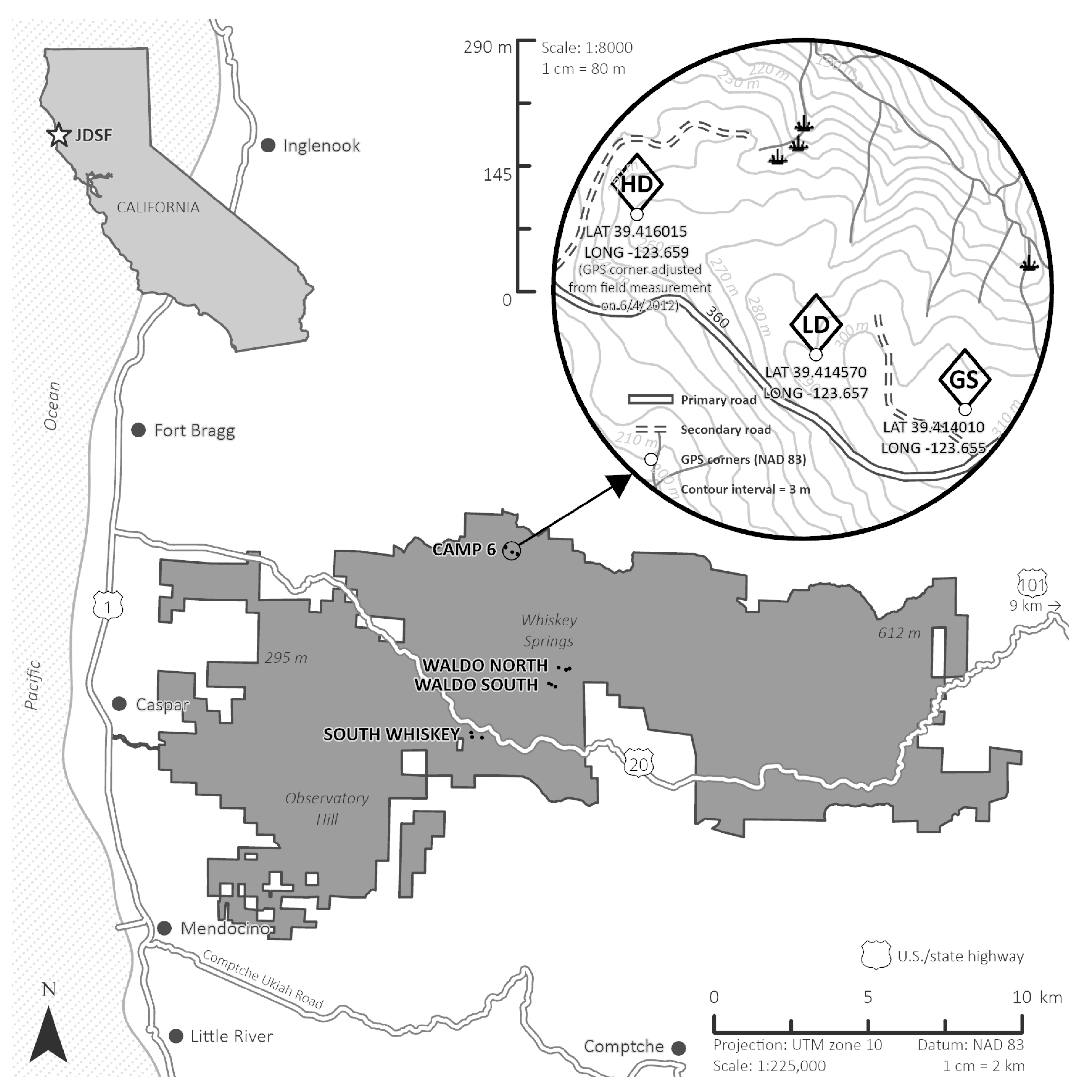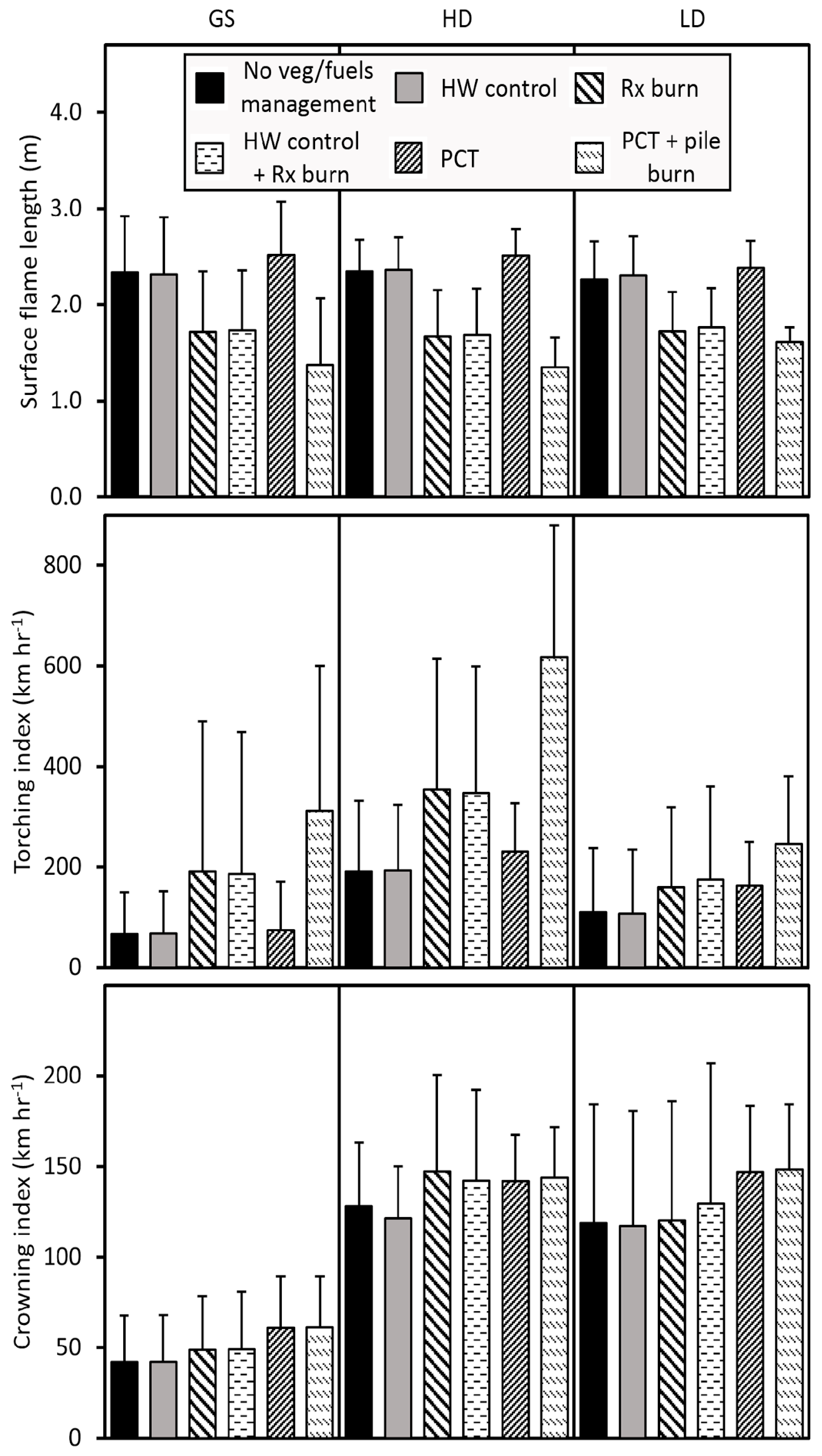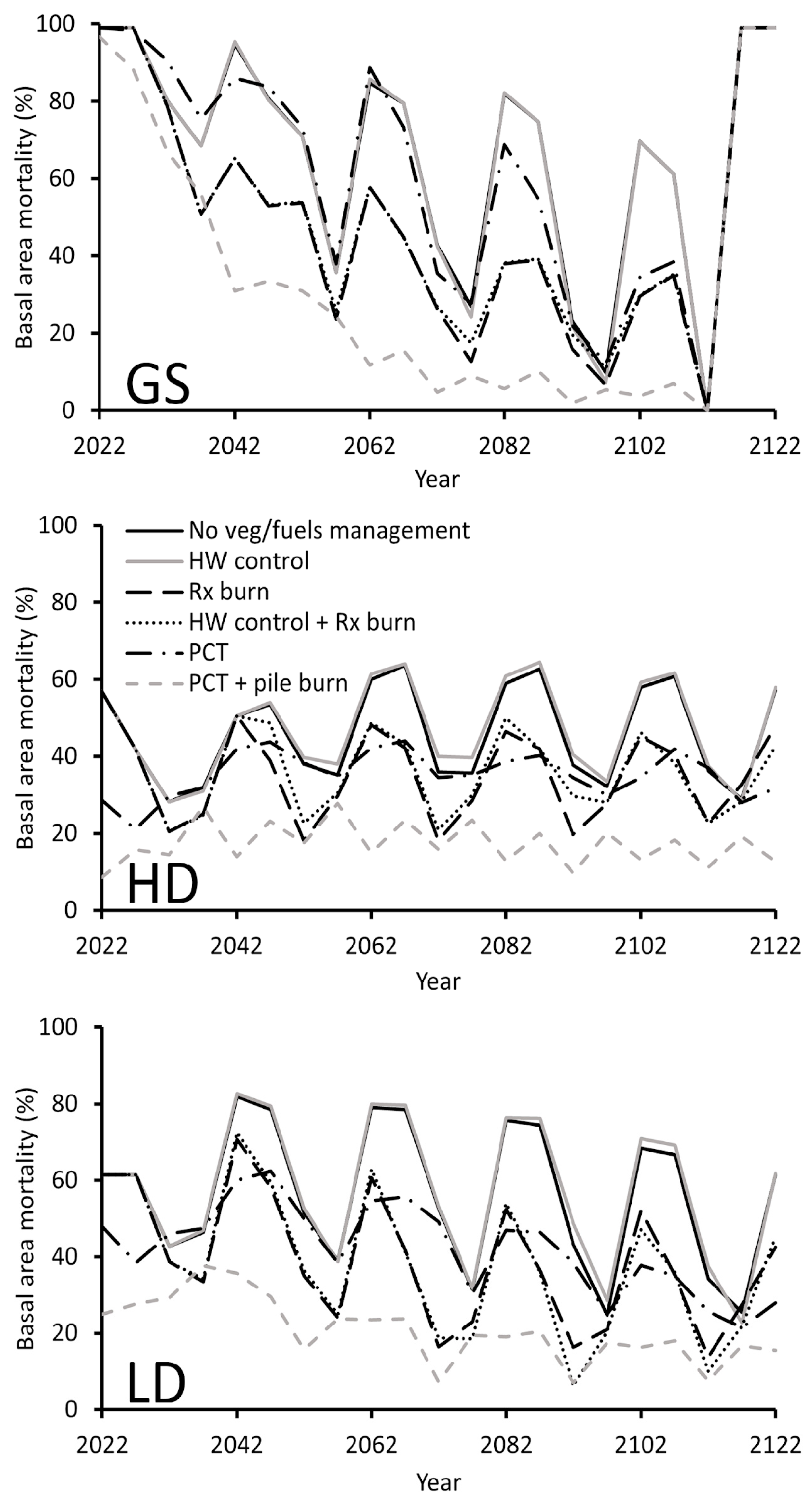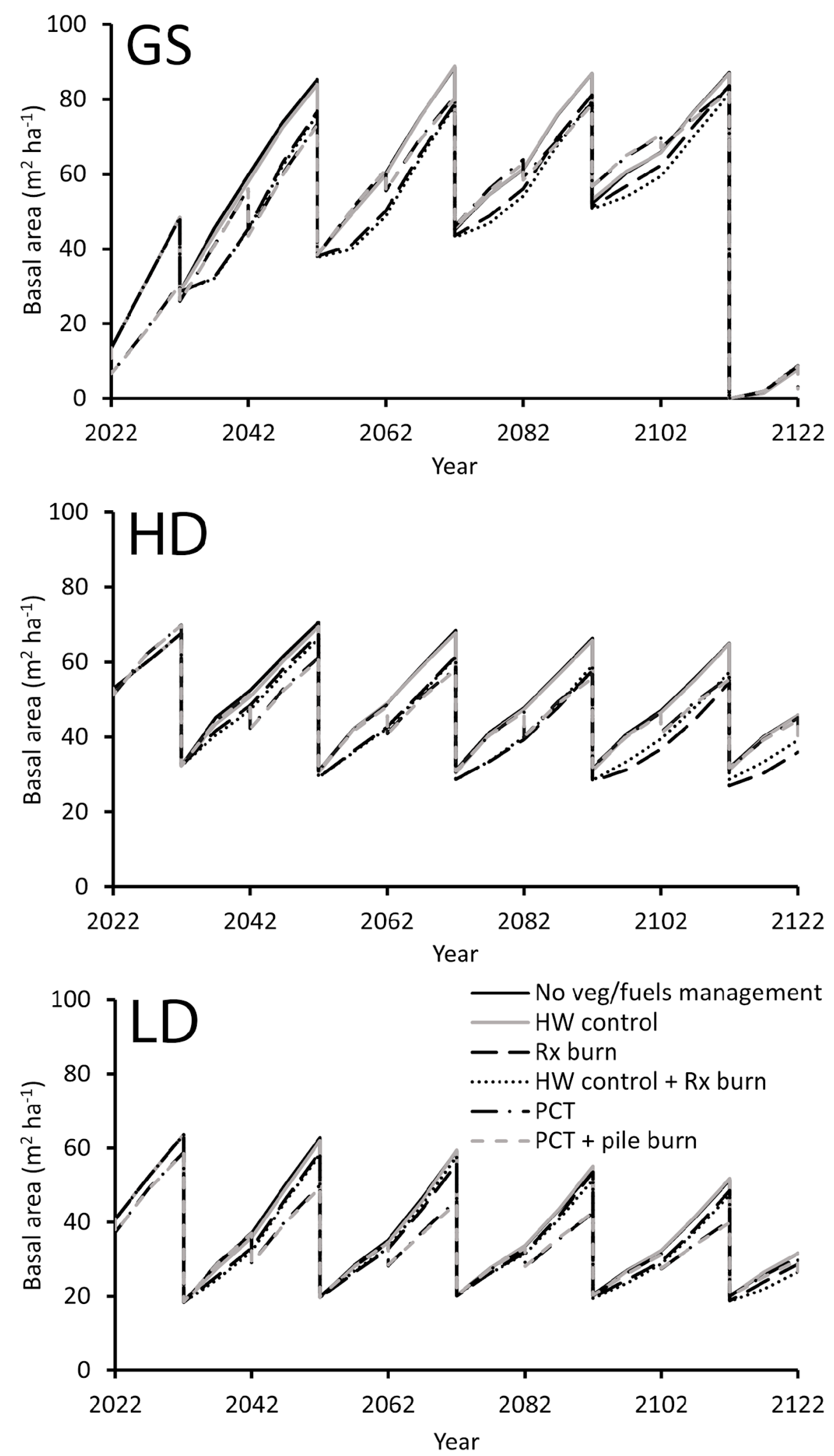Fuels Treatments and Tending Reduce Simulated Wildfire Impacts in Sequoia sempervirens Under Single-Tree and Group Selection
Abstract
1. Introduction
2. Materials and Methods
2.1. Site Description
2.2. Experimental Design
2.3. Data Collection
2.4. Data Analysis
2.5. Fire Model Linkages
3. Results
3.1. Wildfire Behavior
3.2. Tree Mortality from Potential Wildfire
3.3. Growth and Yield
4. Discussion
5. Conclusions
Author Contributions
Funding
Data Availability Statement
Acknowledgments
Conflicts of Interest
References
- O’Hara, K.L. Multiaged Silviculture: Managing for Complex Forest Stand Structures; Oxford University Press: Oxford, UK, 2014. [Google Scholar]
- McCarthy, M.A.; Lindenmayer, D.B. Multi-aged mountain ash forest, wildlife conservation and timber harvesting. For. Ecol. Manag. 1998, 104, 43–56. [Google Scholar] [CrossRef]
- Savilaakso, S.; Johansson, A.; Häkkilä, M.; Uusitalo, A.; Sandgren, T.; Mönkkönen, M.; Puttonen, P. What are the effects of even-aged and uneven-aged forest management on boreal forest biodiversity in Fennoscandia and European Russia? A systematic review. Environ. Evid. 2021, 10, 1–38. [Google Scholar] [CrossRef]
- Spiecker, H. Silvicultural management in maintaining biodiversity and resistance of forests in Europe—Temperate zone. J. Environ. Manag. 2003, 67, 55–65. [Google Scholar] [CrossRef]
- Drever, C.R.; Peterson, G.; Messier, C.; Bergeron, Y.; Flannigan, M. Can forest management based on natural disturbances maintain ecological resilience? Can. J. For. Res. 2006, 36, 2285–2299. [Google Scholar] [CrossRef]
- O’Hara, K.L. Multiaged forest stands for protection forests: Concepts and applications. For. Snow Landsc. Res. 2006, 80, 45–55. [Google Scholar]
- O’Hara, K.L.; Ramage, B.S. Silviculture in an uncertain world: Utilizing multi-aged management systems to integrate disturbance. Forestry 2013, 86, 401–410. [Google Scholar] [CrossRef]
- Ma, Q.; Su, Y.; Niu, C.; Ma, Q.; Hu, T.; Luo, X.; Tai, X.; Qiu, T.; Zhang, Y.; Bales, R.C.; et al. Tree mortality during long-term droughts is lower in structurally complex forest stands. Nat. Commun. 2023, 14, 7467. [Google Scholar] [CrossRef]
- Hagmann, R.K.; Hessburg, P.F.; Prichard, S.J.; Povak, N.A.; Brown, P.M.; Fulé, P.Z.; Kerns, B.K.; Lavoie, M.; Landres, P.B.; Long, J.W.; et al. Evidence for widespread changes in the structure, composition, and fire regimes of western North American forests. Ecol. Appl. 2021, 31, e02431. [Google Scholar] [CrossRef]
- Steel, Z.L.; Safford, H.D.; Viers, J.H. The fire frequency–severity relationship and the legacy of fire suppression in California forests. Ecosphere 2015, 6, 1–23. [Google Scholar] [CrossRef]
- IPCC. Contribution of Working Groups I, II and III to the Sixth Assessment Report of the Intergovernmental Panel on Climate Change. In Climate Change 2023: Synthesis Report; Lee, H., Romero, J., Eds.; IPCC: Geneva, Switzerland, 2023; pp. 35–115. [Google Scholar]
- Abatzoglou, J.T.; Williams, A.P. Impact of anthropogenic climate change on wildfire across Western US forests. Proc. Natl. Acad. Sci. USA 2016, 113, 11770–11775. [Google Scholar] [CrossRef]
- Westerling, A.L. Increasing western US forest wildfire activity: Sensitivity to changes in the timing of spring. Philos. Trans. R. Soc. B 2016, 371, 20150178. [Google Scholar] [CrossRef] [PubMed]
- Stephens, S.L. Forest fire causes and extent on United States Forest Service lands. Int. J. Wildland Fire 2005, 14, 213–222. [Google Scholar] [CrossRef]
- Miller, J.D.; Safford, H.D.; Crimmins, M.; Thode, A.E. Quantitative evidence for increasing forest fire severity in the Sierra Nevada and southern Cascade Mountains, California and Nevada, USA. Ecosystems 2009, 12, 16–32. [Google Scholar] [CrossRef]
- Fettig, C.J.; Reid, M.L.; Bentz, B.J.; Sevanto, S.; Spittlehouse, D.L.; Wang, T. Changing climates, changing forests: A western North American perspective. J. For. 2013, 111, 214–228. [Google Scholar] [CrossRef]
- Parks, S.A.; Abatzoglou, J.T. Warmer and drier fire seasons contribute to increases in area burned at high severity in western US forests from 1985 to 2017. Geophys. Res. Lett. 2020, 47, e2020GL089858. [Google Scholar] [CrossRef]
- Brown, P.M.; Swetnam, T.W. A cross-dated fire history from coast redwood near Redwood National Park, California. Can. J. For. Res. 1994, 24, 21–31. [Google Scholar] [CrossRef]
- Varner, J.M.; Jules, E.S. The Enigmatic Fire Regime of Coast Redwood Forests and Why It Matters; USDA Gen. Tech. Rep. PSW-GTR-258: Albany, CA, USA, 2017; pp. 15–18. [Google Scholar]
- Jacobs, D.F.; Cole, D.W.; McBride, J.R. Fire history and perpetuation of natural coast redwood ecosystems. J. For. 1985, 83, 494–497. [Google Scholar] [CrossRef]
- Brown, P.M.; Baxter, W.T. Fire history in coast redwood forests of the Mendocino Coast, California. Fire Ecol. 2003, 9, 2–16. [Google Scholar]
- Lorimer, C.G.; Porter, D.J.; Madej, M.A.; Stuart, J.D.; Veirs, S.D., Jr.; Norman, S.P.; O’Hara, K.L.; Libby, W.J. Presettlement and modern disturbance regimes in coast redwood forests: Implications for the conservation of old-growth stands. For. Ecol. Manag. 2009, 258, 1038–1054. [Google Scholar] [CrossRef]
- Agee, J.K.; Skinner, C.N. Basic principles of forest fuel reduction treatments. For. Ecol. Manag. 2005, 211, 83–96. [Google Scholar] [CrossRef]
- Noss, R.F. The Redwood Forest; Island Press: Washington, DC, USA, 2000. [Google Scholar]
- Muma, R.; Webb, L.W.; Zald, H.S.J.; Boston, K.; Dagley, C.M.; Berrill, J.-P. Dynamics of stump sprout regeneration after transformation to multiaged management in coast redwood forests. For. Ecol. Manag. 2022, 515, 120236. [Google Scholar] [CrossRef]
- Keyes, C.R.; Varner, J.M. Pitfalls in the Silvicultural Treatment of Canopy Fuels. Fire Manag. Today 2006, 66, 46–50. [Google Scholar]
- Sugihara, N.G. (Ed.) Fire in California’s Ecosystems; University of California Press: Berkeley, CA, USA, 2006. [Google Scholar] [CrossRef]
- Baines, P.G. Physical mechanisms for the propagation of surface fires. Math. Comput. Model. 1990, 13, 83–94. [Google Scholar] [CrossRef]
- Keane, R.E. Wildland Fuel Fundamentals and Applications; Springer International Publishing: Cham, Switzerland, 2015. [Google Scholar] [CrossRef]
- Martinson, E.J.; Omi, P.N. Performance of fuel treatments subjected to wildfires. In Proceedings of the Fire, Fuel Treatments, and Ecological Restoration Conference, Fort Collins, CO, USA, 16–18 April 2002. [Google Scholar]
- Scott, J.H.; Reinhardt, E.D. Assessing Crown Fire Potential by Linking Models of Surface and Crown Fire Behavior; RMRS-RP-29; USDA Forest Service, Rocky Mountain Research Station: Fort Collins, CO, USA, 2001; 59p. [Google Scholar]
- Berrill, J.P.; O’Hara, K.L. Simulating multiaged coast redwood stand development: Interactions between regeneration, structure, and productivity. West. J. Appl. For. 2009, 24, 24–32. [Google Scholar] [CrossRef]
- Caratti, J.; Duncan, C.; Keane, E.; Key, C.; Benson, C.; Sutherland, S.; Gangi, J. FIREMON: Fire Effects Monitoring and Inventory System; USDA Gen. Tech. Rep. RMRS-GTR-164-CD; U.S. Department of Agriculture, Forest Service, Rocky Mountain Research Statio: Fort Collins, CO, USA, 2006; 15p.
- Krumland, B.; Eng, H. Site Index Systems For Major Young-Growth Forest and Woodland Species in North California; Calif. For. Report No.4; California Department of Forestry & Fire Protection: Monterey, CA, USA, 2005; pp. 1–220. [Google Scholar]
- FVS Staff. Klamath Mountains (NC) Variant Overview—Forest Vegetation Simulator; Revised 3 April 2023; USDA Internal Rep.: Fort Collins, CO, USA, 2008; 65p. [Google Scholar]
- Crookston, N.L. Climate-FVS Version 2: Content, Users Guide, Applications, and Behavior. In USDA Forest Service—General Technical Report RMRS-GTR; Department of Agriculture, Forest Service, Rocky Mountain Research Station: Fort Collins, CO, USA, 2014; pp. 1–38. [Google Scholar]
- Rebain, S.A.; Reinhardt, E.; Crookston, N.L.; Beukema, S.J.; Kurz, W.A.; Greenough, J.A.; Robinson, D.C.E.; Lutes, D.C. The Fire and Fuels Extension to the Forest Vegetation Simulator: Updated Model Documentation (Internal Report); U.S. Department of Agriculture, Forest Service, Forest Management Service Center: Lancaster, CA, USA, 2022. [Google Scholar]
- Ritchie, M.W.; Berrill, J.-P. Precommercial thinning in California forests. In Reforestation Practices for Conifers in California; Stewart, W., Ed.; Forest Vegetation Management Conference: Redding, CA, USA, 2020; Chapter 10. [Google Scholar]
- O’Hara, K.L.; Gersonde, R.F. Stocking control concepts in uneven-aged silviculture. Forestry 2004, 77, 131–143. [Google Scholar] [CrossRef]
- Berrill, J.-P.; Webb, L.A.; DeYoung, K.L.; Dagley, C.M.; Bodle, C.G.; Simpson, S.M. Development of redwood regeneration after conifer partial harvest and hardwood management. For. Sci. 2020, 67, 72–82. [Google Scholar] [CrossRef]
- Heinsch, F.A.; Andrews, P.L. BehavePlus Fire Modeling System, Version 5.0: Design and Features; General Technical Report; RMRS-GTR-249; USDA, Forest Service Rocky Mountain Research Station: Fort Collins, CO, USA, 2010. [Google Scholar]
- Anderson, H.E. Aids to Determining Fuel Models for Estimating Fire Behavior; General Technical Report INT-GTR-122; U.S. Department of Agriculture, Forest Service, Intermountain Forest and Range Experiment Station: Rocky Mountain Research Station: Ogden, UT, USA, 1982. [Google Scholar]
- Rothermel, R.C. A Mathematical Model for Predicting Fire Spread in Wildland Fuels; Research Paper INT-115; USDA Forest Service, Intermountain Forest and Range Experiment Station: Ogden, UT, USA, 1972. [Google Scholar]
- Andrews, P.L. Modeling Wind Adjustment Factor and Midflame Wind Speed for Rothermel’s Surface Fire Spread Model; General Technical Report; RMRS-GTR-266; USDA Forest Service, Rocky Mountain Research Station: Fort Collins, CO, USA, 2012; pp. 1–39. [Google Scholar]
- Reinhardt, E.D.; Keane, R.E.; Brown, J.K. First Order Fire Effects Model: FOFEM 4.0 User’s Guide INT-GTR-344 US Department of Agriculture; Forest Service, Intermountain Research Station: Ogden, UT, USA, 1997. [Google Scholar]
- Berrill, J.P.; Han, H.S. Carbon, harvest yields, and residues from restoration in a mixed forest on California’s coast range. For. Sci. 2017, 63, 128–135. [Google Scholar] [CrossRef]
- Oliver, W.W.; Lindquist, J.L.; Strothmann, R.O. Young-growth redwood stands respond well to various thinning intensities. West. J. Appl. For. 1994, 9, 106–112. [Google Scholar] [CrossRef]
- van Mantgem, P.J.; Stephenson, N.L.; Knapp, E.; Battles, J.; Keeley, J.E. Long-term effects of prescribed fire on mixed conifer forest structure in the Sierra Nevada, California. For. Ecol. Manag. 2011, 261, 989–994. [Google Scholar] [CrossRef]
- Ager, A.A.; Finney, M.A.; Kerns, B.K.; Maffei, H. Modeling wildfire risk to northern spotted owl (Strix occidentalis caurina) habitat in Central Oregon, USA. For. Ecol. Manag. 2007, 246, 45–56. [Google Scholar] [CrossRef]
- Berrill, J.-P.; Howe, R.A. Multiaged redwood responds well to partial harvest and herbicide treatments. Can. J. For. Res. 2019, 49, 1425–1433. [Google Scholar] [CrossRef]
- Herbert, C.; Fried, J.S.; Butsic, V. Validation of Forest Vegetation Simulator model finds overprediction of carbon growth in California. Forests 2023, 14, 604. [Google Scholar] [CrossRef]
- Katuna, T.A.; Collins, B.M.; Stephens, S.L. Prescribed fires effects on actual and modeled fuel loads and forest structure in southern coast redwood (Sequoia sempervirens) forests. Fire Ecol. 2024, 20, 100. [Google Scholar] [CrossRef]
- Prichard, S.J.; Hessburg, P.F.; Hagmann, R.K.; Povak, N.A.; Dobrowski, S.Z.; Hurteau, M.D.; Kane, V.R.; Keane, R.E.; Kobziar, L.N.; Kolden, C.A.; et al. Adapting western North American forests to climate change and wildfires: 10 common questions. Ecol. Appl. 2021, 31, e02433. [Google Scholar] [CrossRef]





| Silviculture | Fuel Loading (tons ha−1) | Canopy Characteristics | |||||||
|---|---|---|---|---|---|---|---|---|---|
| Harvest Prescription | Vegetation/Fuel Management | Litter | FWD | CWD | Live Herbs | Live Shrubs | Total Surface | CBH (m) | CBD (kg m−3) |
| GS | none | 6.1 | 42.8 | 45.4 | 0.54 | 0.98 | 126.5 | 6.0 | 1.19 |
| HW control | 5.8 | 42.2 | 45.9 | 0.54 | 1.00 | 125.8 | 6.0 | 1.20 | |
| Rx burn | 3.7 | 14.2 | 30.4 | 0.54 | 0.96 | 60.1 | 6.4 | 1.07 | |
| HW control + Rx burn | 3.6 | 14.2 | 31.5 | 0.54 | 0.95 | 61.3 | 6.1 | 1.08 | |
| PCT | 5.9 | 46.9 | 50.6 | 0.54 | 1.17 | 136.0 | 6.8 | 0.69 | |
| PCT + pile burn | 5.7 | 21.1 | 11.7 | 0.54 | 1.17 | 65.5 | 7.1 | 0.68 | |
| HD | none | 7.8 | 43.6 | 48.6 | 0.55 | 0.79 | 142.2 | 13.5 | 0.38 |
| HW control | 7.2 | 43.2 | 52.0 | 0.55 | 0.81 | 144.5 | 13.5 | 0.39 | |
| Rx burn | 4.9 | 13.8 | 30.8 | 0.55 | 0.71 | 64.7 | 13.8 | 0.37 | |
| HW control + Rx burn | 4.8 | 13.5 | 31.6 | 0.55 | 0.74 | 65.0 | 13.9 | 0.37 | |
| PCT | 6.7 | 48.6 | 54.5 | 0.54 | 0.81 | 151.6 | 17.0 | 0.26 | |
| PCT + pile burn | 6.5 | 20.9 | 11.4 | 0.54 | 0.81 | 73.7 | 17.3 | 0.25 | |
| LD | none | 6.2 | 40.2 | 32.0 | 0.59 | 1.20 | 113.5 | 10.3 | 0.61 |
| HW control | 6.0 | 40.4 | 35.0 | 0.59 | 1.23 | 116.5 | 10.4 | 0.61 | |
| Rx burn | 3.7 | 11.6 | 18.4 | 0.59 | 1.20 | 46.6 | 9.8 | 0.62 | |
| HW control + Rx burn | 3.5 | 11.6 | 20.1 | 0.59 | 1.24 | 48.2 | 11.3 | 0.61 | |
| PCT | 5.1 | 42.5 | 37.0 | 0.61 | 1.52 | 119.6 | 13.2 | 0.28 | |
| PCT + pile burn | 4.8 | 18.1 | 8.2 | 0.61 | 1.54 | 60.5 | 13.5 | 0.27 | |
| Harvest Prescription | Vegetation/Fuel Management | 100-Year Harvest Volume (m3 ha−1) | Standing Volume at Year 100 (m3 ha−1) |
|---|---|---|---|
| GS | none | 5221 | - |
| HW control | 5270 | - | |
| Rx burn | 4201 | - | |
| HW control + Rx burn | 3960 | - | |
| PCT | 5309 | - | |
| PCT + pile burn | 5299 | - | |
| HD | none | 5146 | 2051 |
| HW control | 5148 | 1897 | |
| Rx burn | 4689 | 1420 | |
| HW control + Rx burn | 4646 | 1536 | |
| PCT | 5265 | 2033 | |
| PCT + pile burn | 5213 | 2076 | |
| LD | none | 4001 | 1162 |
| HW control | 3979 | 1152 | |
| Rx burn | 3687 | 992 | |
| HW control + Rx burn | 3604 | 965 | |
| PCT | 4016 | 1172 | |
| PCT + pile burn | 4094 | 1149 |
Disclaimer/Publisher’s Note: The statements, opinions and data contained in all publications are solely those of the individual author(s) and contributor(s) and not of MDPI and/or the editor(s). MDPI and/or the editor(s) disclaim responsibility for any injury to people or property resulting from any ideas, methods, instructions or products referred to in the content. |
© 2025 by the authors. Licensee MDPI, Basel, Switzerland. This article is an open access article distributed under the terms and conditions of the Creative Commons Attribution (CC BY) license (https://creativecommons.org/licenses/by/4.0/).
Share and Cite
Wilder, J.D.; Shuttle, K.A.; Kane, J.M.; Berrill, J.-P. Fuels Treatments and Tending Reduce Simulated Wildfire Impacts in Sequoia sempervirens Under Single-Tree and Group Selection. Forests 2025, 16, 1000. https://doi.org/10.3390/f16061000
Wilder JD, Shuttle KA, Kane JM, Berrill J-P. Fuels Treatments and Tending Reduce Simulated Wildfire Impacts in Sequoia sempervirens Under Single-Tree and Group Selection. Forests. 2025; 16(6):1000. https://doi.org/10.3390/f16061000
Chicago/Turabian StyleWilder, Jade D., Keith A. Shuttle, Jeffrey M. Kane, and John-Pascal Berrill. 2025. "Fuels Treatments and Tending Reduce Simulated Wildfire Impacts in Sequoia sempervirens Under Single-Tree and Group Selection" Forests 16, no. 6: 1000. https://doi.org/10.3390/f16061000
APA StyleWilder, J. D., Shuttle, K. A., Kane, J. M., & Berrill, J.-P. (2025). Fuels Treatments and Tending Reduce Simulated Wildfire Impacts in Sequoia sempervirens Under Single-Tree and Group Selection. Forests, 16(6), 1000. https://doi.org/10.3390/f16061000







